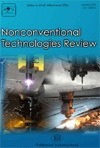EXPLORING NICKEL NANOPARTICLE SYNTHESIS THROUGH LASER ABLATION IN LIQUID
Abstract
Metallic nanoparticles are of considerable importance in various industrial domains due to their unique properties, including a high surface area-to-volume ratio and exceptional catalytic activity. These nanoparticles are widely utilized in fields such as catalysis, electronics, and biomedicine, where they significantly enhance efficiency and performance. This study reports the synthesis of nickel nanoparticles via laser ablation in liquid, employing a 99% pure nickel target, and their characterization using several analytical techniques, including Dynamic Light Scattering (DLS), Atomic Force Microscopy (AFM), Scanning Electron Microscopy (SEM), Energy-Dispersive X-ray Spectroscopy (EDX) and TEM (Transmission electron microscopy). The resulting nanoparticles exhibited sizes ranging from 7 to 40 nm, possessing both anionic and cationic characteristics, along with a narrow size distribution and excellent stability. For the experiments, wavelengths of 1064, 532, and 355 nm were employed, with a pulse frequency of 10 Hz and an ablation duration of 20 minutes, corresponding to a total of 12,000 pulses. Ultrapure water and ultrapure water with various concentrations of NaCl were used as liquid suspensions.
References
2. Suryanarayana, C. (2001). Mechanical alloying and milling. Progress in Materials Science, 46(1–2), 1-184.
3. Mafuné, F., Kohno, J., Takeda, Y., Kondow, T., & Sawabe, H. (2000). Formation of gold nanoparticles by laser ablation in aqueous solution of surfactant. Journal of Physical Chemistry B, 104(39), 9111-9117.
4. Pfeiffer, K., Kley, E. B., & Chichkov, B. N. (1999). Fabrication of nanoparticle arrays by electron beam lithography. Applied Surface Science, 139(1–2), 12-16.
5. Chen, Y., & Zhang, L. (2010). Sub-10 nm patterning of nanoparticle arrays by focused ion beam. Nano Research, 3(12), 879-887.
6. Brinker, C. J., & Scherer, G. W. (2013). Sol-gel science: The physics and chemistry of sol-gel processing. Academic Press.
7. Bhushan, B. (2004). Chemical vapor deposition of coatings. In Springer Handbook of Nanotechnology. Springer, Berlin, Heidelberg.
8. Spanhel, L., & Anderson, M. A. (1991). Semiconductor clusters in the sol-gel process: quantized aggregation, gelation, and crystal growth in concentrated ZnO colloids. Journal of the American Chemical Society, 113(8).
9. Byrappa, K., & Yoshimura, M. (2012). Handbook of Hydrothermal Technology. William Andrew.
10. Capek, I. (2004). Preparation of metal nanoparticles in water-in-oil (w/o) microemulsions. Advances in Colloid and Interface Science, 110(1–2), 49-74.
11. Iravani, S. (2011). Green synthesis of metal nanoparticles using plants. Green Chemistry, 13(10), 2638-2650.
12. Lin, Y., Cui, X., (2005). Electrochemical deposition of metal nanoparticles on carbon nanotubes. Nano Letters, 5(9), 1939-1944.
13. Neel Narayan, Ashokkumar Meiyazhagan, Robert Vajtai, Metal Nanoparticles as Green Catalysts, Materials (Basel), November 2019
14. Isao Matsui, Nanoparticles for Electronic Device Applications: A Brief Review, Journal of Chemical Engineering of Japan, Vol 38, No 8, 2005, 536-546.

